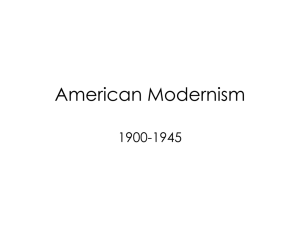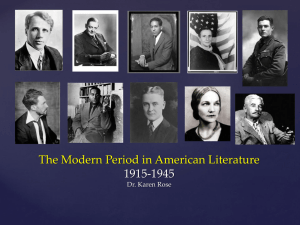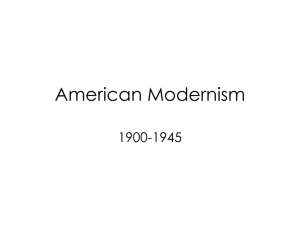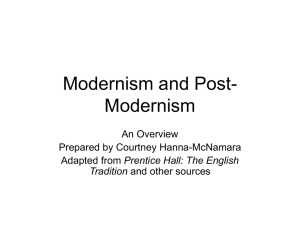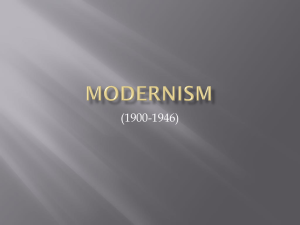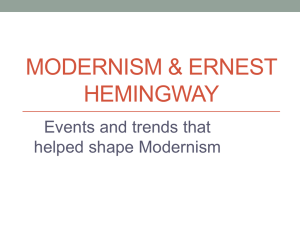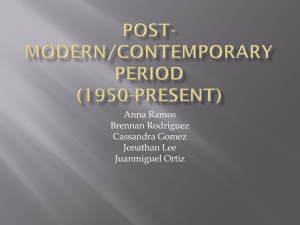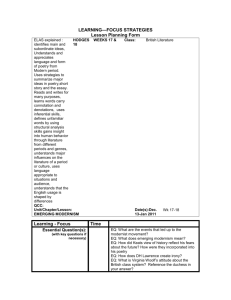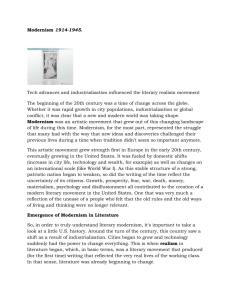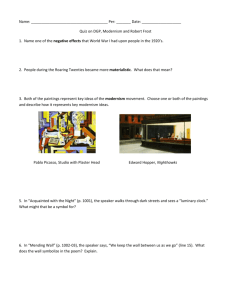Modernism in American Literature: Presentation Overview
advertisement
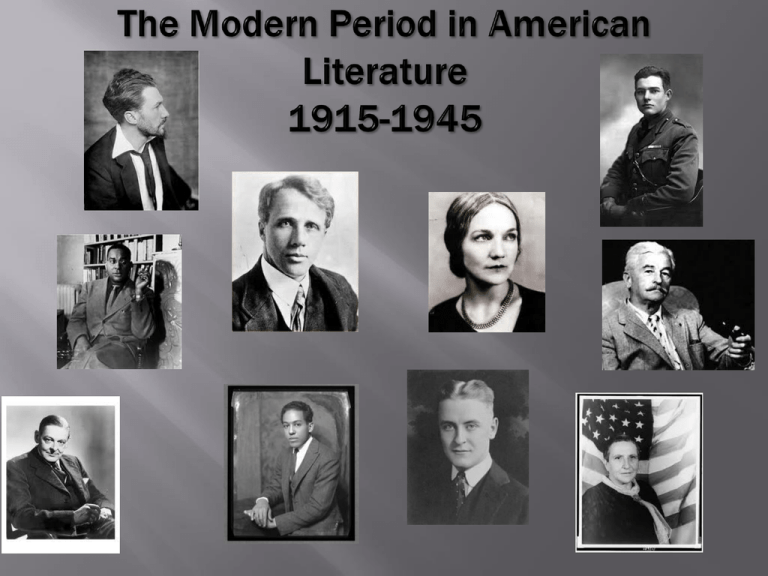
In order to fully understand Modernism, one must be a Historian Philosopher Literary Critic Artist Isn’t that fun? Many historians argue that America’s cultural coming of age occurs during this time. The artistic innovations of Modernism are viewed as a response to dramatic historical, cultural, and economic events. Pre-Modern World Modern World Ordered Chaotic Meaningful Futile Optimistic Pessimistic Stable Fluctuating Faith Loss of faith Morality/Values Collapse of Morality/Values Clear Sense of Identity Confused Sense of Identity and Place in the World WWI Urbanization Industrialization Immigration Technological Evolution Growth of Modern Science 1914 – World War I begins. President Wilson declares America’s neutrality. 1917 – The U.S. enters World War I to “make the world safe for democracy.” 1918 – World War I ends 8.7 million people died for reasons many people could not understand “Once I thought to write a history of the immigrants in America. Then I discovered that the immigrants were American history.”-- Oscar Handlin Before World War I, people believed that technology was a sign of progress and that it would help to serve humanity. The horrors of technology applied to warfare, however, highlighted the ambiguities of “progress.” Machine guns, tanks, submarines, airplanes, flame throwers, and poison gas proved that technology could be used for mass violence. 1920 – The Nineteenth Amendment gave women the right to vote. 1920 - Prohibition begins after the Eighteenth Amendment forbids the “manufacture, sale, or transportation of intoxicating liquors.” 1933 – The Eighteenth Amendment is repealed. 1923 – Ku Klux Klan membership rises to a reported 4 million. 1929 – The U.S. Stock Market crashes 1930s – The Great Depression 1939 – France and England declare war on Germany when Hitler invades Poland. World War II begins. 1941 - Japan attacks Pearl harbor, and America enters WWII. 1942 - President Roosevelt initiates the Manhattan Project, a research and development project to build the atomic bomb. 1945 - Allied troops liberate German concentration camps, American bombers drop napalm in Tokyo, the U.S. drops atomic bombs on Hiroshima and Nagasaki, Japan surrenders, World War II ends. The Style of Literary Modernism Modernism’s literary forms are innovative and, often, challenging. Writers were willing to disrupt traditional notions of order, sequence, and unity. They risked a certain amount of incoherence for the sake of experimentation. Instead of predictable rhymes and forms, Modern poetry is sometimes chaotic, as if to mirror the randomness of modern life and to challenge the reader’s notion of order. Stream of Consciousness Stream of consciousness is a style that some Modern writers use to portray the inner workings of a character’s mind. Writers catalog or describe the character’s thoughts, impressions, emotions, and ideas in rapid succession and without any interpretation or explanation by an outside narrator. Writers who employ this style believe that it more accurately represents the confused and sometimes random jumps of the human mind. Alienation Characteristics of Literary Modernism Existential Nihilism Fragmentary Techniques Emphasis on the Experimental Collapsed Plots Shifts in Perspective, Tone and Voice Alienation During the Modern period, many young Americans felt like outsiders within their own culture. It was difficult for them to come to terms with the unnecessary suffering and enormous loss of life caused by war. Many artists were also troubled by the racism and sexism that was prevalent in American culture. This helps explain why many Modernists experimented with their own styles, rather than tap into the traditional literary forms of their culture. The pervasive sense of alienation that many writers felt led them to leave the U.S. and live in “voluntary exile” in England and Europe. Often referred to as “expatriates,” writers as diverse as Gertrude Stein, Ernest Hemingway, T.S. Eliot, Ezra Pound, Robert Frost, Langston Hughes, and Sherwood Anderson spent years living abroad. In fact, some of them never returned home to the U.S. Alienation “You are all a lost generation.” -Gertrude Stein (quoted by Ernest Hemingway as an epigraph to his 1926 novel, The Sun Also Rises) Existential Nihilism Many modernists rejected traditional philosophical and religious systems of belief in favor of Existential Nihilism, which suggests a meaningless, chaotic, Godless world. Existentialists believe that the individual has the sole responsibility for giving his/her own life meaning and living life passionately and sincerely, in spite of many obstacles and distractions including despair, angst, absurdity, boredom, and death. Existential Nihilists believe that life itself is without intrinsic meaning and that individuals or even the entire human race is insignificant. Compared with earlier writing, modernist literature is notable for what it omits—the explanations, interpretations, connections, summaries, and distancing that provide continuity, perspective, and security in traditional literature. The idea of order, sequence, and unity in works of art is sometimes abandoned because they are now considered by writers as only expressions of a desire for coherence rather than actual reflections of reality. The long work will be an assemblage of fragments, the short work a carefully realized fragment. Some modernist literature registers more as a collage. This fragmentation in literature was meant to reflect the reality of the flux and fragmentation of one’s life. Experimentation Art is artifact rather than reality Organized non-sequentially Experience portrayed as layered, allusive, discontinuous, using fragmentation and juxtaposition. Ambiguous endings—open endings which are seen as more representative of reality. The phrase “make it new,” attributed to Ezra Pound, became a rallying cry for writers who participated in this cultural movement. The modernists were highly conscious that they were being modern—that they were “making it new”—and this consciousness is manifest in the modernists’ radical use of a kind of formlessness. It will seem to begin arbitrarily, to advance without explanation, and to end without resolution, consisting of vivid segments juxtaposed without cushioning or integrating transitions. It will suggest rather than assert, making use of symbols and images instead of statements. The reader must participate in the making of the poem or story by digging the coherent structure out that, on its surface, it seems to lack. Therefore, the search for meaning, even if it does not succeed, becomes meaningful in itself. Its rhetoric will be understated, ironic. The inclusion of all sorts of material previously deemed “unliterary” in works of high seriousness involved the use of language that would also previously have been thought improper, including representations of the speech of the uneducated and the inarticulate, the colloquial, slangy, and the popular. The traditional educated literary voice, conveying truth and culture, lost its authority. Prose writers strove for directness, compression, and vividness. They were sparing of words. The average novel became quite a bit shorter than it had been in the nineteenth century. Modern fiction tends to be written in the first person or to limit the reader to one character’s point of view on the action. This limitation accorded with the modernist sense that “truth” does not exist objectively but is the product of a personal interaction with reality. The selected point of view was often that of a naïve or marginal person—a child or an outsider—to convey better the reality of confusion rather than the myth of certainty. Art in which multiple views are presented simultaneously in flattened, geometric way. Picasso Georges Braque Protest against the barbarism of the War and oppressive intellectual rigidity; Anti-art: Strives to have no meaning; Interpretation dependent entirely on the viewer; Intentionally offends. Duchamp Raoul Hausmann Grew out of Dada and automatism. Reveals the unconscious mind in dream images, the irrational, and the fantastic, Impossible combinations of objects depicted in realistic detail. Magritte Dali Jackson Pollock Grew out of Cubism Added implied motion to the shifting planes and multiple observation points of the Cubists Celebrated natural as well as mechanical motion and speed Glorified danger, war, and the machine Giacomo Balla Kandinsky Conclusion Modernism was a massive movement that included a broad range of authors, styles, and themes. It was a revolt against the conservative values of Realism. Modernism underscored the abstract, unconventional, largely uncertain ethic brought on by rapidly changing technology and dramatic cultural shifts. Due to the richness of the art and literature produced during this time, it is sometimes referred to as the 20th Century Renaissance. Baym, Nina, ed. The Norton Anthology of American Literature. New York: Norton, 1998. Print. Harmon, William, and C. Hugh Homan, eds. A Handbook to Literature. New Jersey: Prentice-Hall, 1996. Print. Kimmelman, Burt, ed. The Facts on File Companion to 20th Century American Poetry. New York: Facts on File, 2005. Print. Lathbury, Roger. American Modernism (1910-1945): American Literature in its Historical, Cultural, and Social Contexts. New York: Facts On File, 2006. Print. Siepmann, Katherine Baker, ed. Benét’s Reader’s Encyclopedia. New York: Harper-Collins, 1948. Print.
